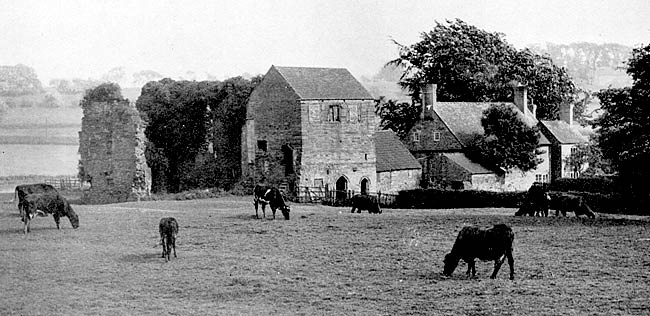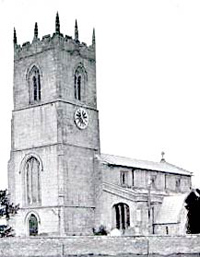< Previous | Contents | Next >
Beautiful Vale
BEAUVALE PRIORY. In a most-happily named stretch of the busy Erewash valley, in the charming seclusion of green fields and forest-side, stands all that is left of a priory which came into history six centuries ago. It was founded in 1343 by Nicholas de Cantelupe, a great soldier and friend of Edward the Third, whose castle was at Greasley a mile away.

Beauvale Priory from the north-west in the 1930s.
It was the last priory to be founded in this county, and the first to be touched with the tragedy of the scaffold in Henry the Eighth's war on the monasteries. For nearly 200 years it was the home of Carthusian monks, who lived in seclusion from the world and gave themselves to hard work and great privation. Life in the Beautiful Vale perhaps consoled them for the austerity of their daily routine, and these great gardeners, whose beds were of straw and their raiment of hair cloth, made this lovely place blossom as the rose.
Tragedy came upon it in 1535, when Prior Robert Laurence and Prior Houghton went with Prior Webster of Axholme to put forward petitions concerning the king's attitude to the monasteries. When questioned by Thomas Cromwell they acknowledged their loyalty to the king but refused to regard him as head of the church, and they were condemned and hanged at Tyburn. From his prison window Sir Thomas More, who was to follow them in a few weeks, saw them led out to execution, and said to his daughter, "Dost thou not see that these blessed fathers be now as cheerfully going to their death as bridegrooms to their marriage?"
Today a farmhouse stands where the priory stood, and among the ruins seen in the outbuildings is part of the prior's house. Part of the remains have been roofed to house the cattle which come and go by the old doorways, and close by are great ivied walls with traces of a fine window.
In the woods behind the priory is a charming spot known as Robin Hood's Well, where forget-me-nots are a delight to see.
The Drum-Major's Daughter

Beckingham church, c.1920.
BECKINGHAM. A mile and a half from the Trent and Lincolnshire, it is big and pleasant with trees, treasuring a beautiful old church which comes chiefly from the three medieval centuries, but has a plain tub font taking its story back to Norman days.
The lower part of the lofty tower is 600 years old, but its buttresses and the top storey are a century younger. There are windows of both these times, and the clerestory is 15th century. The two fine nave arcades with nail-head on the capitals are 13th and 14th century, and between the chancel and its chapel are two 15th century bays. The chancel, though much rebuilt, keeps three 13th century seats for priests, with richly moulded arches and detached shafts with capitals of natural foliage. The piscina is 700 years old.
A lovely medieval relic is part of the oak chancel screen, now across the tower arch and much restored. There is an ancient image bracket in the south aisle, carved with the strange figure of a little man armed with a sword, his crowned head stuck on to his body at a right angle. Four curious gargoyle heads outside the north aisle have staring eyes and bulging cheeks.
On the wall near the tower is a brass plate engraved with a sinking ship and three or four boats taking women and children from the wreck. Lined up on deck are the heroes who wait for death rather than crowd the boats, and others are clinging to the rigging. It is in memory of Marion Parkinson, one of the survivors of the troopship Birkenhead which was wrecked off the Cape in 1852; she was the daughter of the drum major. One of about 190 who were saved, she saw 500 soldiers and sailors stand in line to go down with the sinking ship. She lies in the cemetery near the church.
